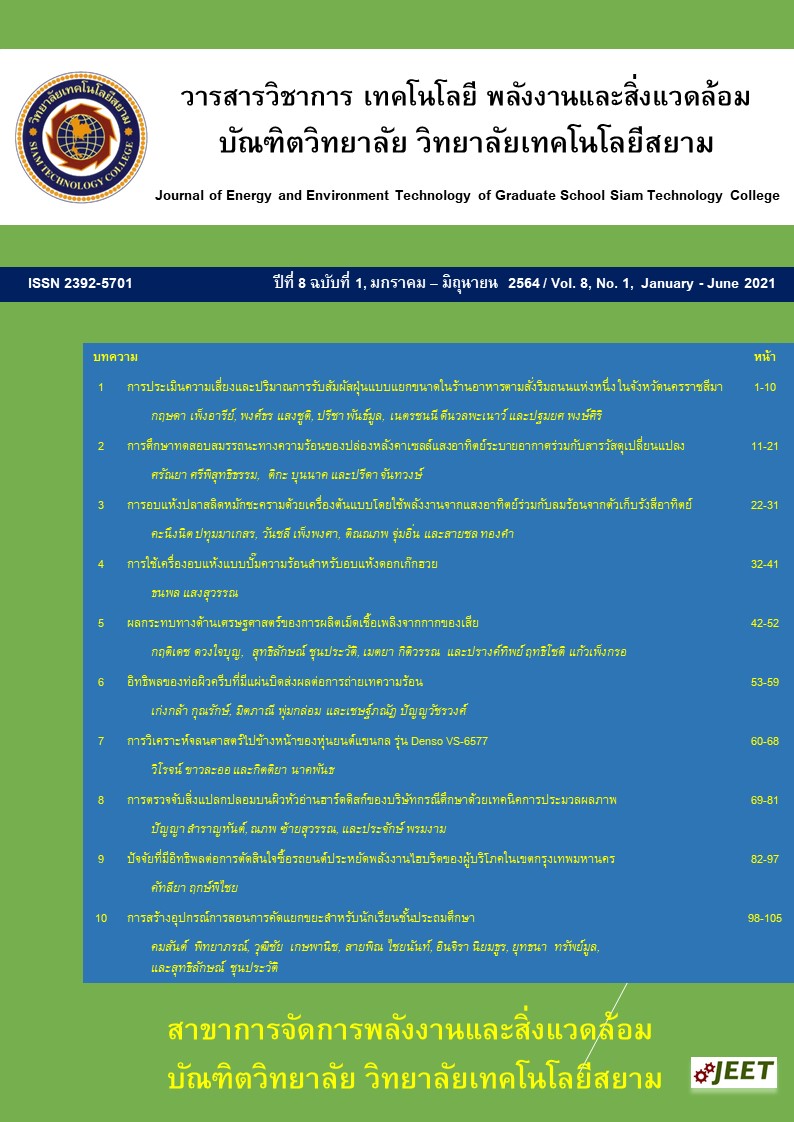DRYING OF SNAKESKIN GOURAMI MARINATED IN SUAEDA MARITIMA BY USING SOLAR ENERGY COMBINED WITH HOT AIR FROM SOLAR COLLECTOR
Main Article Content
Abstract
This research aims to design and build a solar energy dryer prototype combined with hot air from the solar collector for snakeskin gourami marinated in Suaeda Maritima. The developed dryer consists of 3 main parts, including a drying chamber with an area of 3.24 m2, a solar collector with an area of 1.305 m2, and a trolley for tipping snakeskin gourami marinated. In the experiment, one kilogram of snakeskin gourami marinated in Suaeda was prepared. To study the optimal drying condition, they were dried at different air velocities of 1, 2, and 3 m/s. The results showed that the air velocity of 3 m/s was the fastest drying time of 80 minutes, which snakeskin gourami marinated in Suaeda Maritima has a final moisture content of 180%db. In the drying, two-term equation was the suitable mathematical model in this study. The highest R2 is 0.9925 and the lowest and RMSE are 0.0001 and 0.0044, respectively. Besides, the energy consumption of the solar dryer was also considered. In this study, the energy sources in the drying process were derived from three parts, including (1) hot air energy from the solar collector, (2) solar energy in the part of the solar chamber, and supplied electrical power to the fan for circulation and suction of hot air. Interestingly, the overall efficiency of energy consumption for the solar dryer was 18.068%.
Article Details

This work is licensed under a Creative Commons Attribution-NonCommercial-NoDerivatives 4.0 International License.
เนื้อหาและข่อมูลในบทความที่ลงตีพิมพ์ในวารสารวิชาการ เทคโนโลยี พลังงาน และสิ่งแวดล้อม บัณฑิตวิทยาลัย วิทยาลัยเทคโนโลยีสยาม ถือเป็นข้อคิดเห็นและความรับผิดชอบของผู้เขียนบทความโดยตรง ซึ่งกองบรรณาธิการวารสารไม่จำเป็นต้องเห็นด้วย หรือว่าร่วมรับผิดชอบใด ๆ
บทความ ข้อมูล เนื้อหา รูปภาพ ฯลฯ ที่ได้รับการตีพิมพ์ในวารสารวิชาการ เทคโนโลยี พลังงาน และสิ่งแวดล้อม บัณฑิตวิทยาลัย วิทยาลัยเทคโนโลยีสยาม ถือเป็นลิขสิทธิ์ของวารสารวิชาการ เทคโนโลยี พลังงาน และสิ่งแวดล้อม บัณฑิตวิทยาลัย วิทยาลัยเทคโนโลยีสยาม หากบุคคล หรือหน่วยงานใดต้องการนำทั้งหมด หรือส่วนหนึ่งส่วนใดไปเผยแพร่ต่อ หรือเพื่อกระทำการใด ๆ จะต้องได้รับอนุญาต เป็นลายลักษณ์อักษรจากวารสารวิชาการ เทคโนโลยี พลังงาน และสิ่งแวดล้อม บัณฑิตวิทยาลัย วิทยาลัยเทคโนโลยีสยาม เท่านั้น
References
สายชล ทองคำ และศิริวิมล สายเวช. (2560). การพัฒนาผลิตภัณฑ์ปลาสลิดแดดเดียวหมักชะคราม. กรุงเทพฯ: มหาวิทยาลัยราชภัฏจันทรเกษม.
ธีรเดช ใหญ่บก และคณะ. (2553). การพัฒนากระบวนการอบแห้งปลาด้วยเครื่องอบแห้งพลังงานแสงอาทิตย์-ไฟฟ้าภายใต้สภาพภูมิอากาศภาคใต้ของประเทศไทย, วารสารมหาวิทยาลัยทักษิณ, 12 (3): 109 – 118.
เวียง อากรชี และคณะ. (2559). การศึกษาการใช้โรงอบแห้งพลังงานแสงอาทิตย์ร่วมกับเครื่องอบลมร้อนแบบชั้นวางสำหรับอบแห้งผักและผลไม้. วารสารวิศวกรรมเกษตรแห่งประเทศไทย, 22 (1): 39 – 45.
วรนุช แจ้งสว่าง. (2556). ตู้อบแห้งแสงอาทิตย์ชนิดอากาศร้อนไหลลงแบบกะทัดรัด. วิศวกรรมสารฉบับวิจัยและพัฒนา. 24 (1): 37 – 41.
กระทรวงอุตสาหกรรม. มาตรฐานผลิตภัณฑ์ชุมชน “ปลาแดดเดียว” (มผช.298/2557). [ออนไลน์]. เข้าถึงได้จาก https://www.tistr.or.th/tistrblog/wp-content/uploads/2018/06/25.pdf (10 ก.ย. 2563).
กลยุทธ ดีจริง และ เอกสิทธิ์ สุทธะพินทุ. (2561). “การอบแห้งรังไหมด้วยเครื่องอบแห้งพลังงานแสงอาทิตย์ชนิดรับรังสีอาทิตย์แบบผสม”: จลนพลศาสตร์การอบแห้ง สมรรถนะเครื่องอบแห้ง และสมบัติเชิงกลของเส้นไหมดิบ”. วารสารเกษตรพระวรุณ, 15(1): 216-228.
เสริม จันทร์ฉาย. (2560). เทคโนโลยีอบแห้งพลังงานรังสีอาทิตย์. พิมพ์ครั้งที่ 1. นครปฐม : บริษัทเพชรเกษมพรินติ้ง จำกัด.
Hii, C.L., C.L. Law, and M. Cloke. (January 2009). “Modeling using a new thin layer drying model and product quality of cocoa.” Journal of Food Engineering, 90(2): 191-198.


